Table of Contents
Transportation in Animals and Plants Class 7 Extra Questions Science Chapter 11
Transportation in Animals and Plants Class 7 Science Extra Questions Very Short Answer Type Questions
Question 1 .
Name some useful products or materials that are carried by blood.
Answer:
Food, water and oxygen are the products that are carried by blood to every part of the body.
Question 2.
Circulatory system consists of three major organs. Name those organs.
Answer:
The circulatory system consists of three major organs, i.e., blood, blood vessels and heart.
Question 3.
Give the name of blood component which is liquid and contains 90% water.
Answer:
The sticky liquid part of the blood, containing 90% water is called plasma.
Question 4.
Name the organ which is located in the chest cavity with its lower tip slightly tilted towards the left. [NCERT Exemplar; HOTS]
Answer:
The heart is located in the chest cavity with its lower tip slightly tilted towards the left.
Question 5.
RBC contains a red coloured pigment which carries oxygen with it. What is the pigment called?
Answer:
The red coloured pigment of RBC that carries oxygen with it is called haemoglobin.
Question 6.
Veins have valves which allow blood to flow only in one direction. Arteries do not have valves. Yet the blood flows in one direction only. Can you explain why? [NCEAT Examplar; HOTS]
Answer:
Veins have valves to prevent blood from flowing backwards and pooling, whereas arteries pump blood at very high pressures, which naturally prevents back flow
Question 7.
In which form, the oxygen is transported to various body parts by haemoglobin?
Answer:
The red pigment, haemoglobin binds with oxygen to form oxyhaemoglobin which is transported to various body parts.
Question 8.
Certain greenish-blue lines appear just below the skin of our hands and leg. What are these?
Answer:
The greenish-blue lines that appear just below the skin of our hands and legs are veins.
Question 9.
Human blood group is divided into how many groups? Name them.
Answer:
Human blood group is divided into four groups. These are A, B, AB and O.
Question 10.
Waste carbon dioxide and urea are removed from our body by which organs?
Answer:
The carbon dioxide is removed by lungs while urea is removed from the body by kidney.
Question 11.
Blood is a fluid connective tissue. Justify.
Answer:
Blood is a fluid tissue which connects all the parts of body with each other.
Question 12.
Blood performs various functions including protection against infections. How?
Answer:
Blood contains WBC which forms the defense of our body. They eat antigens and fights aganist infections.
Question 13.
Pulse rate can indicate the health states of an individual. How?
Answer:
Pulse rate will increase or decrease from normal rate if a person is not well.
Question 14.
Usually veins carry deoxygenated blood except in one case. Specify.
Answer:
Pulmonary veins carry oxygenated blood from lungs to heart.
Question 15.
State the function of valves ?
Answer:
Valves prevent the back flow of blood between chambers of heart.
Question 16.
Name the functional units of the major excretory organ of humans.
Answer:
Kidney is the major excretory organ and nephrons are its functional units.
Question 17.
Exchange of gases, food and other substances occurs between arteries and veins. How does this exchange happen?
Answer:
Exchange of substances between arteries and veins occurs via capillaries.
Question 18.
Measuring of heartbeats is a significant step during health checkups. Name the instrument used for the same.
Answer:
Stethoscope
Question 19.
Kidneys are the major excretory organs in humans. How will the waste products released will be excreted out if the kidneys are damaged or unfunctional? [HOTS]
Answer:
Artificial ways of waste removal are used like dialysis which are referred to as artificial kidneys.
Question 20.
Arteries have a very thick and elastic walls. Why?
Answer:
Arteries carry blood at a very high pressure due to pumping action of heart hence, the need of thicker walls.
Question 21.
Skin is also considered as an excretory organ. Give reason if you agree. [HOTS]
Answer:
Yes, skin is an excretory organ as it secretes waste products by releasing sweat from the surface.
Question 22.
Heart has three chambers, two ventricles and one atrium. Is it right or wrong?
Answer:
Wrong, the heart has four chambers. Two auricles and two ventricles.
Question 23.
Arteries and veins carry blood to and from the heart. Which of these carry the blood?
(a) Back to the heart from all organs.
(b) Away from heart for distribution in all organs.
Answer:
(a) Veins
(b) Arteries
Question 24.
Urine is called an excretory product. Why?
Answer:
Urine is the mixture of urea and other unwanted salts with water which is needed to be excreted out as its presence in blood can make a person ill.
Question 25.
Sponges and Hydra do not possess any circulatory system then how do they carry out distribution of food and other substances?
Answer:
The water in which these organisms live brings them food and oxygen as it enters their bodies.
Question 26.
If the heartbeats of a person are more than 72-80 beats per minute. What does it signify?
Answer:
The faster heartbeats signify that heart is pumping more blood to the organs as they need increased oxygen and energy supply.
Question 27.
What is the purpose of using stethoscope by doctors?
Answer:
A stethoscope reads heartbeats as diaphragm amplies the rounds of heartbeat when placed on specific areas.
Question 28.
Urinary bladder is the part of human excretory system. What is its role in excretion?
Answer:
Bladder stores the excretory product released after filtration from kidney and excrete it out at specific times.
Transportation in Animals and Plants Class 7 Science Extra Questions Short Answer Type Questions
Question 1.
Arrange the following statements in the correct order in which they occur during the formation and removal of urine in human beings.
(a) Ureters carry urine to the urinary bladder.
(b) Wastes dissolved in water is filtered out as urine in the kidneys.
(c) Urine stored in urinary bladder is passed out through the urinary opening at the end of the urethra.
(d) Blood containing useful and harmful substances reaches the kidneys for filtration.
(e) Useful substances are absorbed back into the blood.
Answer:
The correct order of the formation and removal of urine in human beings is
(d) Blood containing useful and harmful substances reaches the kidneys for filtration.
(e) Useful substances are absorbed back into the blood.
(b) Wastes dissolved in water is filtered out as urine in the kidneys.
(a) Ureters carry urine to the urinary bladder.
(c) Urine stored in urinary bladder is passed out through the urinary opening at the end of the urethra.
Question 2.
Name the tissues of a plant which carries
(a) water and minerals from roots to the leaves.
(b) food from the leaves to the other parts of the plant.
Answer:
The tissue which carries
(a) water and minerals from roots to leaves is xylem.
(b) food from the leaves to the other parts of the plant is phloem.
Question 3.
Look at figure and draw another figure of the same set up as would be observed after a few hours.
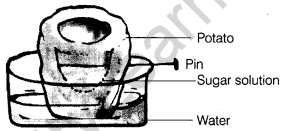
Answer:
After the few hours, the figure will be shown as follows
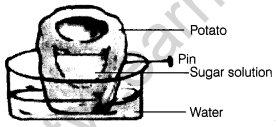
This figure shows that there will be an increase in the level of sugar solution in the potato piece. This increase in the level of sugar solution rises due to water that passes throGgh the wall of potato and goes inside it.
Question 4.
(a) Name the only artery that carries carbon
dioxide rich blood.
(b) Why is it called an artery if it does not carry oxygen-rich blood? [NCERT Exemplar]
Answer:
(a) The only artery that carries carbon dioxide rich blood is pulmonary artery.
(b) The main function of artery is to carry blood away from heart. Also arteries have thick wall and do not contain valves in them. Blood flow in arteries, takes place at high pressure. All these characteristics are found in pulmonary artery. It carries deoxygenated blood from heart to lungs for oxygenation, therefore it is called artery.
Question 5.
Name the process and the organ which help in removing the following wastes from the body.
(a) Carbon dioxide
(b) Undigested food
(c) Urine
(d) Sweat [NCERT Exemplar]
Answer:
| Waste | Process | Organ | |
| (a) | Carbon dioxide | Exhalation | Lungs |
| (b) | Undigested food | Egestion | Large intestine and anus |
| (c) | Urine | Excretion | Kidneys |
| (d) | Sweat | Perspiration
(sweating) |
Sweat glands |
Question 6.
Observe given figure and answer the given question.
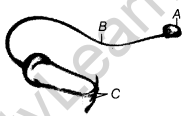
(a) Name the instrument.
(b) Label the parts A, B and C. [NCERT Exemplar]
Answer:
(a) The name of the given instrument is stethoscope.
(b) Labelled diagram of stethoscope.
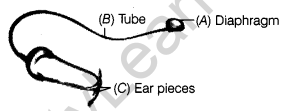
Question 7.
What is the relation between the rate of heartbeat and pulse rate? If a pulse rate of an athlete Is 96/min, what will be the number of his heartbeat at the same time? [HOTS]
Answer:
The rhythmic contraction and relaxation of the muscles of the heart is called heartbeat. Whereas, the rhythmical throbbing of the arteries as the blood is pushed forward through them is called pulse. It can be felt in the wrist, temples, etc.
Pulse rate is the number of heartbeats per minutes. The number of heartbeat is equal to the number of pulse per minute.
Therefore, if a pulse rate of an athlete is 96/min then the number of his heartbeat at the same time will also be 96/min
Question 8.
Give one function of each of the following organs,
(a) Blood vessels
(b) Kidney
(c) Blood platelets
(d) Heart
Answer:
The main function of the following organs are as follows:
(a) Blood vessels These run between the heart and the rest of the body. It helps in the transport of blood between heart and various organs of the body.
(b) Kidney It is called as the ‘magic filters’. It helps in the removal of unwanted substances like urea from the blood.
(c) Blood platelets This component of blood helps in blood clotting and prevents the blood loss from the body.
(d) Heart It is a pumping organ which receives blood from the body through veins and pumps it with enough force into the arteries from where it is carried to the various body parts.
Question 9.
Paheli noticed water being pulled up by a motor pump to an overhead tank of a five storeyed building. She wondered how water moves up to great heights in the tall trees standing next to the building. Can you tell why? [NCERT Exemplar; HOTS]
Answer:
When the water is pulled up by a motor-pump to an overhead tank of a five storeyed building, it moves to a great height due to the suction pull. This pull forms the continuous column of water and water rises up to a great height. Similarly, when transpiration occurs in the plants, water is evaporated and this creates a suction pull in the plants.
Due to this suction pressure, water from the soil rises up through the roots of the plants and reaches to a great height in tall plants.
Question 10.
How is transpiration and translocation different from each other.
Answer:
The differences between transpiration and translocation are
| Transpiration | Translocation |
| The evaporation of water from the leaves of plant is called transpiration. | The transport of soluble products of photosynthesis from leaves (from where they are formed) to the other parts, of plants is called translocation. |
| It takes place through stomata present in the lower surface of leaf. | It occurs in the part of the vascular tissue known as phloem. |
Question 11.
Make a table depicting the function of all chambers of the human heart.
Answer:
The human heart is divided into four chambers, i. e. upper two atrium and lower two ventricles. The functions of these chambers can be tabulated as follows
| Chamber | Function |
| Left atrium | Receives oxygenated blood from lungs through pulmonary veins and pours it into left ventricle. |
| Right atrium | Receives deoxygenated blood from various body parts through superior and inferior vena cava and pours it into right ventricle. |
| Left ventricle | Pumps oxygenated blood to various parts of body through aorta. |
| Right ventricle | Pumps deoxygenated blood into lungs through pulmonary artery. |
Question 12.
How does the water move from root to leaves?
Answer:
The water moves from root to leaves with the help of specialised cells called vascular tissue. Transport of water and nutrients is done by xylem tissue present in plants.
Question 13.
Observe the given diagram of human heart and label all the parts from A to H.
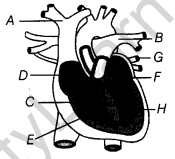
Answer:
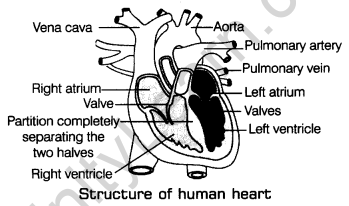
The heart is an organ which beats continuously as a pump for the transport of blood carrying other substances with it, through a network of tubes or blood vessels. The heart pumps blood throughout our life without stopping or relaxing.
Question 14.
The given diagram is of human excretory system. Label the marked parts of it.
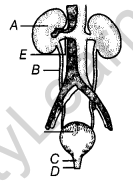
Answer:
The various parts of human excretory system are as follows
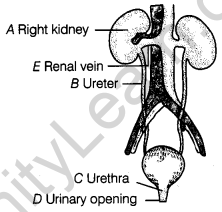
Question 15.
Paheli says her mother puts ladyfinger and other vegetables in water if they are somewhat dry. She wants to know how water enters into them. [HOTS]
Answer:
By soaking the vegetables in water, the skin of the vegetables becomes moist and water starts moving from one cell to another until the vegetables are fresh again.
Question 16.
Why plants absorb a large quantity of water from the soil, then give it off by transpiration?
Answer:
Plants absorb a large quantity of water from the soil because they need nutrients which are dissolved in the water. The excess water evaporates through the stomata present on the leaf surface by the process of transpiration.
Question 17.
List some animals surrounding your locality group them into following groups.
(a) Animals that excrete ammonia in gaseous forms.
(b) Animals that excrete uric acid in the form of pellets.
(c) Animals that excrete urea in the form urine. [HOTS]
Answer:
Some animals that surround us are fish, frog, birds, tadpole larva, snake, cow, man, rat, monkey, lizard, toad and snail.
These can be grouped as follows
(a) Animals that excrete ammonia in gaseous form (i.e. ammonotelics)-Fish, tadpole larva.
(b) Animals that excrete uric acid in the form of pellets (i.e. uricotelics)—Bird, snake, rat, lizard, snail.
(c) Animals that excrete urea in the form of urine (i.e. ureotelics)-Frog, cow, man, monkey, toad.
Question 18.
Human have two major organs that perform transport of materials. Organ ‘A’ is bean-shaped and dark red in colour lie just above the waist. It helps in’removal of ‘Q’, a waste material from blood. The organ ‘S’ is the opening at the end of the urinary bladder through which the waste material is eliminated.
Organ ‘B’ lies in the chest cavity slightly tilted towards the left side. It pumps continuously and pours liquid ‘C’ into arteries and through very fine tube-like structure ‘D’ distributes the liquid to various parts of the body. What are the name of these organs. [HOTS]
Answer:
Organ ‘A’ is kidney which is bean-shaped and helps in the removal of urea (Q) which is a waste material from the blood. ‘S’ is urethra which is the small opening at the end of urinary bladder. Organ ‘B’ is heart which acts as pump. It pumps liquid blood continuously and pours into arteries, and through capillaries (D) which are fine tube-like structure, the blood is distributed to various parts of the body.
Question 19.
The major function of the arteries is to carry to oxygenated blood throughout the body and that of veins is to carry deoxygenated blood from body parts to heart for purification. There is one artery that carries deoxygenated blood and one vein that carries oxygenated blood. Name the artery and vein. [HOTS]
Answer:
The artery which carries deoxygenated blood or blood rich in CO2 is pulmonary artery while the pulmonary vein is one which carries oxygenated blood. The pulmonary artery carries deoxygenated blood from heart to lungs while pulmonary vein carries oxygenated blood from lungs to heart.
Question 20.
Boojho’s uncle was hospitalised and put on dialysis after a severe infection in both of his kidneys.
(a) What is dialysis?
(b) When does it become necessary to take such a treatment?
Answer:
The normal functioning of kidney is necessary for good health of a person. But sometime s the kidney may stop working due to infection or injury. This condition of kidney is called kidney failure which may lead to the accumulation of urea in the blood of a person. Since, urea is a toxic substance which must be removed from the blood. Such person having kidney failure cannot survive unless his blood is filtered periodically through the artificial kidney machine to remove urea. The process used for cleaning the blood of a person by separating the waste product urea from it is called dialysis.This machine removes urea and other waste the product periodically.
The long term solution for the patient suffering from kidney failure is kidney transplantation. In this method, the diseased or damaged kidney is removed and matching kidney is donated by a healthy person. The donated kidney is transplanted in its place by performing surgery.
Question 21.
The internal structure of heart has four chambers.
(a) Name the upper chambers of heart.
(b) Name the lower chambers of heart.
Answer:
The vertical section of heart shows that heart is divided into four compartments called as chambers.
(a) The upper two chambers of heart are called atria or atrium.
(b) The lower two chambers of heart are called ventricles.
Question 22.
Explain in brief the main functions of the structural and functional unit of kidney in excretory system.
Answer:
Kidney is the major excretory organ which consists of thousands of tiny filters called nephrons. The major functions of nephron are
- To filter blood at high pressure which helps in the separation of nitrogenous waste such as urea from the blood.
- It helps in selective re-absorption of some substances (from the initial filtrate which is filtered at a very high pressure). These substances include glucose, amino acid, salts ancf a major amount of water.
Question 23.
What is the special feature present in a human heart which does not allow mixing of blood when oxygen-rich and carbon dioxide-rich blood reach the heart? [NCERT Exemplar]
Answer:
In human, the heart has four chambers. The two upper chambers are called the atria and the two lower chambers are called the ventricles. The partition between the chambers helps to avoid mixing up of blood rich in oxygen with the blood rich in carbon dioxide.
Question 24.
Paheli uprooted a rose plant from the soil. Most of the root tips with root hairs got left behind in the soil. She planted it in a pot with new soil and watered it regularly. Will the plant grow or die? Give reason for your answer. [NCERT Exemplar, HOTS]
Answer:
Possible answers are
- Without the root hairs, the roots will not be able to absorb water and nutrients and the plant will die.
- The stem of the rose plant may grow new roots and the plant will live.
- The rose plant may not be able to survive in a different type of soils.
Transportation in Animals and Plants Class 7 Science Extra Questions Long Answer Type Questions
Question 1.
Priya’s grandfather was taken to the hospital as he was unable to perform excretory processes. Priya heard a nurse talking to her father that her grandfather’s has kidney failure and needs to undergo dialysis. Priya later asked her father as to what is dialysis process and why does grandpa needs it. Her father smiles and tells her all the facts associated with this process.
(a) What do you mean by dialysis?
(b) Why is there a need for dialysis in some people?
(c) Excretion is an important life process. How?
(d) Which is the major excretory organ in humans?
(e) What values do you observe in Priya? [Value Based Question]
Answer:
(a) Dialysis is the process used for cleaning of the blood by separating the waste products in an artificial medium.
(b) Dialysis is needed when the excretory organ of humans, i.e. kidney becomes damaged on unfunctional due to some injury or infection.
(c) Excretion process removes the waste products released in body after the utilisation of food and other components. These products are toxic and may harm us if not removed from our body.
(d) Kidney
(e) Priya is curious, sincere and aware eager to acquire new knowledge.
Question 2.
While learning to ride a bicycle, Boojho lost his balance and fell. He got bruises on his knees and it started bleeding. However, the bleeding stopped after sometime.
(a) Why did the bleeding stop?
(b) What would be the colour of the wounded area and why?
(c) Which type of blood cells are responsible for clotting of blood? [NCERT Exemplar]
Answer:
(a) When a cut or wound starts bleeding after sometime, a clot is formed which plugs the cut and bleeding stops.
(b) Wounded area becomes dark red in colour due to clotting of blood.
(c) The blood clot is formed due to the presence of the cells called platelets in the blood.
Question 3.
Like humans and animals, transportation of water, mineral and nutrients also take place in plants. How?
Answer:
Transport of Substances in Plants
Plants take up water and dissolved minerals from the soil through their roots and transport it to their leaves. The leaves use this water and mineral for synthesising their food by the process called photosynthesis.The food produced by green plants in transported back to all the parts of plant body.
Therefore, it is clear that plants also need a transport system for carrying water, minerals and food through various parts of their body.
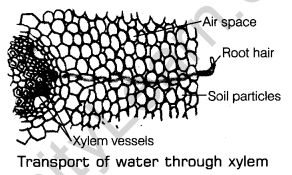
Transport of Water and Minerals
Plant root absorbs the water and mineral from the soil. The roots possess root hair which increase the surface area of the root for absorption of water and minerals nutrient that is dissolved in the water. It is moved from roots up to the stem and leaves through the tube-like tissue called as xylem.
Absorption and flow of water is a continuous process through the xylem tissue. Xylem tissues are the continuous network of channels which connect roots to the leaves through the stem and branches. It thus transports water and minerals to the leaves of the entire plant.
Transport of Food Material
The food manufactured in the leaf is transported to different parts of plants. This transportation of food material from leaves to the other parts of plants is carried out by the tissue called phloem and the process of transport of food material is called translocation. The phloem consists of vessels that are known as sieve tubes.
Question 4.
Blood from heart is carried by certain tube-like structure. What are they? Give the structure and functions of different types of blood carrying tubes.
Answer:
These are tubes or pipes that carry blood throughout the body. It runs between the heart and the rest of the body. There are three major types of blood vessels in the body, i.e. arteries, veins and capillaries.
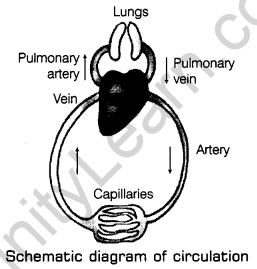
1. Arteries: These carry blood from the heart to all the parts of body. These lie quite deep under our skin and cannot be seen easily. Arteries have thick elastic walls as the blood flows at high pressure due to pumping action from heart through arteries. No valves are present in the arteries. The main artery, i.e. aorta is connected to the left ventricle of the heart. It carries oxygenated blood from the left ventricle to all the parts of body except the lungs. Another artery called pulmonary artery is connected to the right ventricle of the heart and carries deoxygenated blood from the right ventricle to the lungs.
Note: The arteries normally carry oxygenated blood from the heart but one artery called pulmonary artery carries deoxygenated blood from heart to lungs.
2. Veins: These are the blood vessels that carry blood from all the parts of the body back to the heart. These tube-like blood vessels are situated just under the skin and can easily be seen as greenish-blue tubes or lines below the skin. These carry deoxygenated blood from the body parts to heart. Veins have thin walls and blood flows at low pressure through the veins. Therefore, veins have valves in them which allow the blood to flow in one direction and prevent the back flow of blood in veins.
Usually veins carry deoxygenated blood but pulmonary vein that is connected to the left atrium of the heart, carries oxygenated blood from the lungs to the heart.
Functions of Blood
Various functions of blood are
- It transports substances like digested food from the small intestine to the other parts of the body.
- It carries water to all the parts of the body.
- It carries oxygen and C02 during circulation.
- It carries waste products like urea from liver to kidney for excretion in urine.
- It protects the body from disease.
Question 5.
While riding a bike, Mason fell from it due to loss of balance. He got up and realised that he was bleeding from several wounds badly. He panicked and started to run but Mansi who was looking at him, stopped him and told him to clean his wound with a clean cloth and that blood will stop coming in a while. Mason noticed that he has stopped bleeding after sometime and a hard covering was appearing on his wounds.
(a) Why did the bleeding stop after a while?
(b) What is blood and what type of cells are responsible for clotting?
(c) What of values do you think Mansi have? [Value Based Question]
Answer:
(a) Bleeding stops after sometime because some specialised cells start forming a hard covering called clot at the site of wound.
(b) Bleeding is a fluid connective tissue present in all parts of the body. Platelets are responsible for formation of clot.
(c) Mansi is helpful, knowledgeable and interested in science subject.
Question 6.
Read the following terms given below,
root hairs xylem urethra
arteries kidneys veins
atria capillaries heart
ureter phloem urinary bladder
Group the terms on the basis of the categories given below.
(a) Circulatory system of animals.
(b) Excretory system in human.
(c) Transport of substances in plants. {NCERT Exemplar]
Answer:
The terms on the basis of the categories can be grouped as follows
(a) Circulatory system of human Arteries, atria, capillaries, veins, heart.
(b) Excretory system in human
Urethra, kidneys, ureter, urinary bladder.
(c) Transport of substances in plants Root
Question 7.
(a) What are the different blood groups in human?
(b) Define blood group compatibility.
(c) Make a table to show the donor blood group and recipient blood group.
Answer:
(a) The blood group of an individual human being always remains unchanged throughout their life. Karl Landsteiner described that human blood can be divided into four groups, i.e. A, B, AB and O. These are named on the basis of substance present in the blood (RBC). Every man has one of these four groups of blood which is inherited from parents to offspring and is never changed.
If a person gets injured and heavy blood loss occurs, there is a need to give blood of other person to the patient. The person who gives the blood is called donor while the person who receives the blood is called
recipient.
(b) The process of donation of blood from one person to another is called blood transfusion. Before donation, the blood group must be matched because transfusion of different groups can be dangerous. The RBCs of the patient receiving blood will stick together and may cause death of the patient. This matching of blood group is called blood group compatibility. It can be shown as follows :
(c)
|
Blood group |
Can donate blood to | Can receive blood from |
| A | A and AB | A and O |
| B | B and AB | B and O |
| AB | AB | All the group, i.e. A, B, AB and O |
| O | All the group, i.e. A, B, AB and 0 | O |
Transportation in Animals and Plants Class 7 Science Extra Questions Miscellaneous Questions
Multiple Choice Questions
Question 1.
The muscular tube through which stored urine is passed out of the body is called
(a) kidney
(b) ureter
(c) urethra
(d) urinary bladder
Answer:
(c) urethra
Question 2.
Which among the following contain haemoglobin?
(a) Red blood cells
(b) White blood cells
(c) Both (a) and (b)
(d) None of these
Answer:
(a) Red blood cells
Question 3.
They are pipe-like consisting of a group of specialised cells. They transport substances and form a two-way traffic in plants. Which of the following terms qualifies for the features mentioned above?
(a) Xylem tissue
(b) Vascular tissue
(c) Root hairs
(d) Phloem tissue
Answer:
(d) Phloem tissue
Question 4.
The organ which controls the blood circulation in body is
(a) Liver
(b) Lungs
(c) Heart
(d) Kidney
Answer:
(c) Heart
Question 5.
The absorption of nutrients and exchange of respiratory gases between blood and tissues takes place in [NCERT Exemplar]
(a) veins
(b) arteries
(c) heart
(d) capillaries
Answer:
(d) capillaries
Question 6.
A certain type of cells, helps in destruction of disease causing microorganisms are known as
(a) thrombocytes
(b) white blood cells
(c) osteocytes
(d) red blood cells
Answer:
(b) white blood cells
Question 7.
In which of the following parts of human body are sweat glands absent? [NCERT Exemplar]
(a) Scalp
(b) Armpits
(c) Lips
(d) Palms
Answer:
(c) Lips
Question 8.
The lower chambers of heart is called
(a) atria
(b) ventricles
(c) aorta
(d) vena cava
Answer:
(b) ventricles
Question 9.
Aquatic animals like fish excrete their wastes in gaseous form as
(a) oxygen
(b) hydrogen
(c) ammonia
(d) nitrogen
Answer:
(c) ammonia
Question 10.
The filtration of blood is done by
(a) heart
(b) kidney
(c) blood
(d) urethra
Answer:
(b) kidney
Question 11.
In a tall tree which force is responsible for pulling water and minerals from the soil? [NCERT Exemplar]
(a) Gravitational force
(b) Transportation force
(c) Suction force
(d) Conduction force
Answer:
(c) Suction force
Question 12.
Transport of water in plants takes place through
(a) xylem
(b) vascular bundle
(c) phloem
(d) None of these
Answer:
(a) xylem
Fill in the Blanks
1. Blood consists of …………, ……………, …………….. and platelets.
2. Human heartbeats about ………… times per minute in an adult person.
3. ………… and ………… are removed along with water as sweat.
4. ………… are the vessels which carry CO2 rich blood from body parts to heart.
5. The ………… is an organ which beats continuously to act as a ………… .
6. Heart is located in the ………… .
7. Doctors use ………… as a device to amplify the sound of heart.
8. The parts or organs involved in excretion to form the ………… .
9. Heart has four ………… called as chambers.
10. The function of kidney is to filter the ………… to ………… remove
Answer:
1. plasma, RBCs, WBCs
2. 70-80
3. Salt, urea
4. Veins
5. heart, pump
6. chest cavity
7. stethoscope
8. excretory system
9. compartments
10. blood, urea
True/False
1. The vascular tissue for the transport of food in plants is called xylem.
2. The rhythmic contraction and relaxation of heart is called heartbeat.
3. Haemoglobin is the red colour pigment present in blood.
4. Atria are the two upper chambers of the heart.
5. Kidney is a rounded structure used to filter the blood.
6. Platelets help in blood clotting.
7. Digested food, oxygen and CO2 passes through the walls of the capillaries.
8. Nephrons are the tiny filtering units of the kidney.
9. WBC protects the body from diseases.
10. The process of cleaning the blood of human by using a kidney machine is called dialysis.
11 . Sweat is secreted by sweat glands, present in our skin.
Answer:
1. False, the vascular tissue for the transport of food In plant is called phloem.
2. True
3. True
4. True
5. False, kidney filters the blood and is a bean-shaped structure.
6. True
7. True
8. True
9. True
10. True
11. True
Match the Columns
Question 1.
Match the Column I with Column II. [NCERT Exemplar]
| Column 1 | Column II |
| (a) Right ventricle | (i) Pushes blood into the pulmonary artery. |
| (b) Pulmonary veins | (ii) Take deoxygenated blood from the heart to lungs. |
| (c) Left atrium | (iii) Receives blood from different parts of the body. |
| (d) Pulmonary arteries | (iv) Bring oxygenated blood from lungs to the heart. |
| (e) Left ventricle | (v) Pushes blood into the aorta. |
| (f) Right auricle | (vi) Receives deoxygenated blood from the pulmonary veins. |
Question 2.
Match the Column I with Column II
| Column I | Column II |
| (a) Circulatory system | (i) Deoxygenated blood |
| (b) Arteries | (ii) Heart and blood vessels |
| (c) Veins | (iii) Oxygenated blood |
| (d) Kidney | (iv) Circulation of blood |
| (e) William Harvey | (v) Excretion |
Question 3.
Match the Column 1 with Column II
| Column I | Column II |
| (a) Lizards | (i) Tube-like structure |
| (b) Ureters | (ii) Blood clotting |
| (c) Root hairs | (iii) Empties blood into the right atrium |
| (d) Platelets | (iv) Largest artery |
| (e) Aorta | (v) Transport of water and minerals |
| (f) Vena cava | (vi) Uric acid |
Answers:
1.
(a)-(i)
(b)-(iv)
(c)-(vi)
(d)-(ii)
(e)-(v)
(f)-(iii)
2.
(a)-(ii)
(b)-(iii)
(c)-(i)
(d)-(v)
(e)-(iv)
3.
(a)-(vi)
(b)-(i)
(c)-(v)
(d)-(ii)
(e)-(iv)
(f)-(iii)






